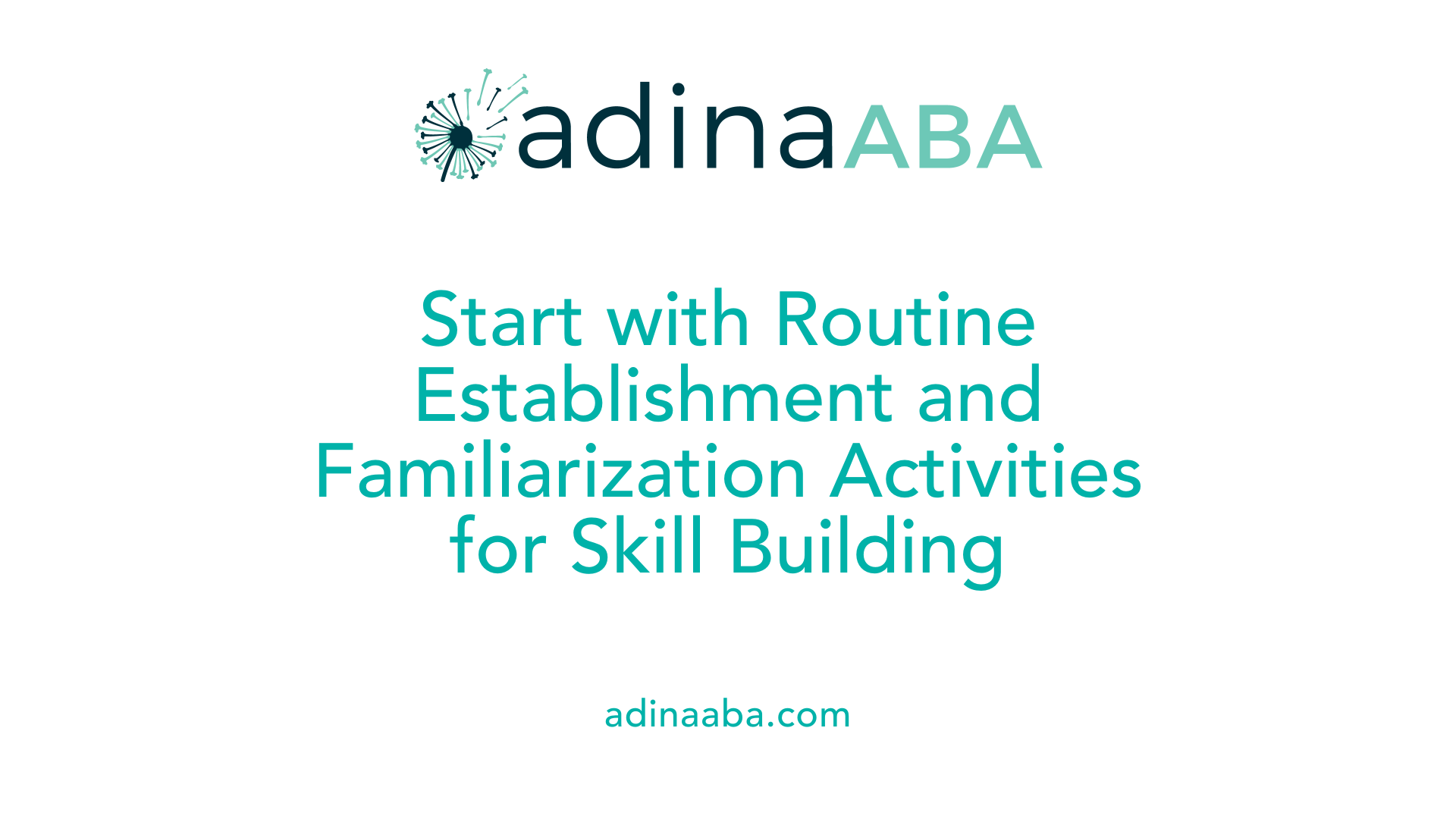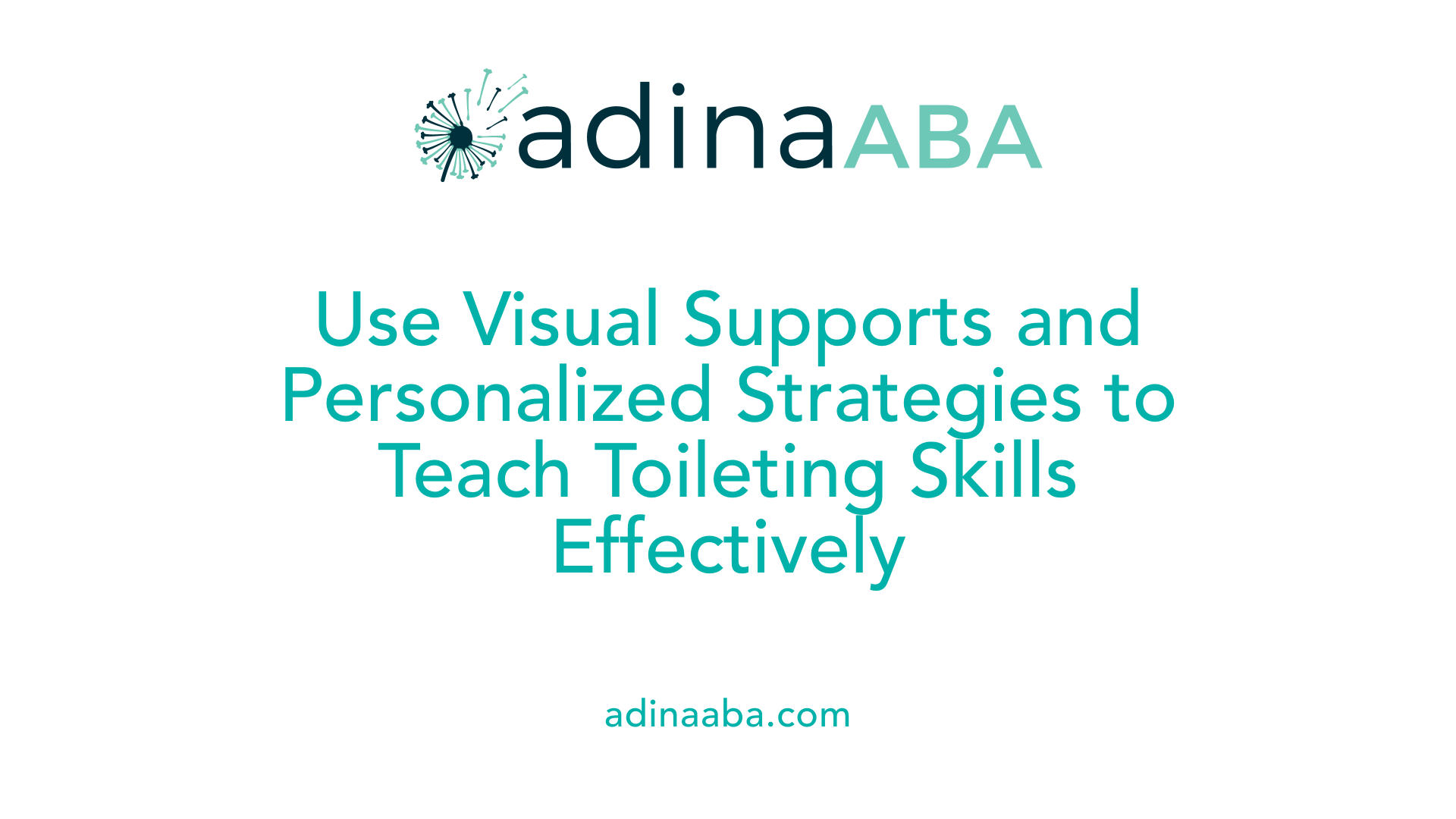How to generalize toileting skills outside the home

Mastering Toileting Skills Across All Settings
For children developing toileting skills, transferring these routines from the familiar environment of home to new settings like public restrooms, schools, or during outings can be challenging yet essential. Proper generalization ensures independence, safety, and comfort, especially for children with developmental disabilities or sensory sensitivities. This article provides a comprehensive guide for caregivers and professionals on how to effectively support children in applying toileting skills across diverse environments through strategic practices, communication techniques, and environmental adjustments.
Understanding Readiness and Preparing the Child

What are some indicators that a child is ready for toileting?
Before beginning formal toileting training, it's important to assess if the child demonstrates certain readiness signs. These include having good bladder control, being able to stay dry for several hours, and showing awareness of bodily sensations indicating the need to go to the bathroom.
Children who recognize when they are eliminating and can communicate this need are better prepared for toileting routines. Additionally, interest in using the toilet, curiosity about bathroom activities, and a desire to be independent with toileting tasks are positive signs.
Other indicators include the ability to follow simple instructions, walk to and sit on the toilet, and tolerate sitting for increasing amounts of time. Ensuring these behaviors are in place can make the training process more successful.
How do you familiarize children with bodily cues?
Teaching children to recognize their bodily cues involves helping them identify sensations like the feeling of a full bladder or bowels. Using visual supports such as social stories and visual schedules helps children understand the sequence of toileting.
Occupational therapists and behavior analysts often use task analysis to break down toileting into manageable steps, emphasizing the child's awareness of when they need to go. Consistent practice and positive reinforcement for noticing and acting on these cues reinforce awareness.
Visual supports, including pictures of physical sensations, can facilitate communication for children with limited verbal skills. Over time, this awareness supports independence and prevents accidents.
What are the initial steps for toileting readiness?
The first steps toward toileting readiness involve establishing routines that promote consistency. Start by incorporating regular opportunities for the child to sit on the toilet, even if they do not initially succeed.
Use visual prompts to cue the child when it's time to go, such as schedule boards or icons indicating bathroom time. Praise and rewards immediately after successful attempts reinforce positive behavior.
Introducing familiarization activities, like visiting the bathroom in a relaxed manner, teaching walking to and sitting on the toilet, and practicing staying seated for a few moments, helps prepare the child.
Gradually, increase the length of time the child sits and shift to scheduled bathroom breaks throughout the day. Carry visual supports and extra clothing during outings to provide consistency.
By combining these steps with positive reinforcement and a patient approach, children can develop the skills necessary for successful toileting outside their home environment.
| Indicator/Strategy | Description | Additional Notes |
|---|---|---|
| Bladder control | Ability to hold urine for hours | Essential before beginning toilet training |
| Bodily cue recognition | Awareness of needing to urinate or defecate | Can be taught using visual supports and cues |
| Routine establishment | Regular schedule of bathroom visits | Helps build consistency and predictability |
| Visual supports | Icons, schedules, social stories | Reduce anxiety and promote understanding |
| Positive reinforcement | Praise, preferred activities, treats | Reinforces successful toileting behaviors |
| Gradual sitting increase | From brief sitting to longer periods | Builds comfort and independence during toileting |
| Environmental familiarity | Visiting various bathrooms, preparing for new settings | Facilitates generalization of toileting skills |
| Communication supports | AAC devices, visual cues, social stories | Help children ask for the bathroom independently |
Familiarity with bodily cues and establishing readiness are foundational for effective toileting training. Using a combination of visual supports, routines, and positive reinforcements tailored to each child's developmental level supports success and ensures skills generalize across various environments. Proper preparation and patience are crucial in helping children develop independence in toileting.
Establishing a Routine and Using Visual Supports

What steps should be taken to prepare for toileting outside of the home?
Preparing for toileting outside the home involves careful planning and making the experience as positive as possible. Parents and caregivers should familiarize themselves with nearby restroom locations at the outset. Turning this into a fun activity, such as a treasure hunt for toilets, can make the process enjoyable.
Packing a travel toileting kit is essential. This kit might include a portable, fold-up potty seat, extra change of clothes, rewards like stickers or small treats, wipes, and hand sanitizer. Bringing these supplies along ensures readiness for accidents and promotes independence.
Practicing visits to public restrooms before outings can help children become comfortable with the environment. During outings, observe and respond promptly to the child's signals, using visual supports such as picture cues or simple prompts to guide them.
Clothing choices matter: opting for easy-to-remove clothing helps streamline bathroom visits. Scheduling regular bathroom breaks during longer trips, such as every 45 minutes to an hour, can prevent accidents and ease anxiety.
Incorporating positive reinforcement, like praise or preferred activities, boosts motivation. Additionally, gradually increasing the distance and duration of outings while maintaining a schedule for bathroom visits supports a smooth transition to toileting outside the familiar home environment.
Overall, consistent routines, preparedness, and patience form the backbone of successful outdoor toileting for children learning these skills.
Implementing Consistent and Systematic Methods

How can caregivers support toileting independence across different environments?
Supporting toileting independence for children with autism across various settings requires a structured, consistent approach. Caregivers should establish clear routines, such as scheduled bathroom visits, to promote familiarity and predictability. Visual supports like picture schedules and icons are effective tools that guide children through the toileting process, helping them understand what is expected regardless of the environment.
Incorporating toileting into daily routines at home, school, and during outings reinforces learned skills. Using visual aids and educational tools tailored to the child's developmental level boosts understanding and retention. Tailoring strategies to the child's temperament and sensory sensitivities is crucial, as it helps reduce anxiety and resistance.
Gradual support, along with positive reinforcement like praise, treats, or preferred activities, builds confidence and cooperation. Communication with family members and school staff ensures consistency, making it easier for children to generalize skills. Preparing for outings by packing portable supports, extra clothing, and familiar items minimizes stress and sets the stage for success. This holistic, multi-setting approach fosters independence and skill retention in diverse environments.
What intensive techniques can promote toileting for children with ASD?
Children with ASD often benefit from intensive, multi-component toileting procedures. These approaches include increasing fluid intake to promote regular urination, using urine alarms to signal when the child needs to go, and scheduling regular bathroom breaks—initially every 10 minutes—that gradually extend to every 45 minutes or an hour as mastery improves.
Behavioral techniques form the foundation of these intensive methods. Task analysis breaks down toileting into manageable steps, while reinforcement, such as praise or preferred items, encourages successful attempts. Handling accidents with positive practice—gentle repetition of desired behaviors without punishment—helps solidify skills.
Training school and therapy staff through behavioral skills training (BST) ensures proper implementation of procedures across settings. Maintaining detailed data collection on toileting behaviors allows caregivers and professionals to monitor progress, identify challenges, and adjust strategies accordingly.
These comprehensive strategies, which may also involve sensory accommodations and environmental adjustments like comfortable seating, aim to increase independence significantly. When combined with consistent routines and tailored support, they can lead to remarkable improvements in toileting skills for children with ASD.
Adapting the Environment for Successful Toileting
What is the role of ABA therapy in toilet training?
Applied Behavior Analysis (ABA) therapy is fundamental in toilet training, especially for children with autism. It provides a structured, personalized approach that emphasizes breaking down skills into manageable steps through task analysis. ABA uses visual supports such as schedules and icons, along with systematic desensitization techniques, to help children tolerate new environments like bathrooms.
Reinforcement methods—such as praise, preferred treats, or activities—are applied immediately after successful toileting attempts to motivate continued effort. Consistent routines and prompts further reinforce learning, reducing anxiety and resistance.
In addition, data collection plays a vital role. By tracking progress through charts and journals, therapists can adjust strategies, ensuring the child's development stays on track. This evidence-based, predictable environment fosters independence, helping children master toileting skills effectively while accommodating their individual needs.
Overall, ABA techniques create a supportive framework that makes learning toileting less stressful and more engaging for children with autism.
How can environmental adjustments facilitate toileting success?
Creating an environment conducive to toileting success involves thoughtful modifications that cater to sensory sensitivities and comfort. Sensory considerations are especially significant for children who experience overwhelming stimuli in typical bathroom settings.
One effective strategy includes ensuring the toilet and bathroom are comfortable and sensory-friendly. This might involve using specialized toilet seats, providing soft lighting, and reducing visual clutter. Addressing auditory sensitivities is also important; for example, covering automatic flush sensors or turning off loud bathroom fans can prevent startling sounds.
Environmental modifications extend to minimizing visual distractions and controlling sensory input. Using supportive tools like sensory-friendly bathroom modifications can help ease anxiety, making the experience less intimidating.
Furthermore, familiarizing children with new environments gradually—such as visiting grandparents’ houses or fast-food restaurants—helps them generalize skills across settings. Carrying portable visual supports and extra clothing ensures preparedness and comfort during outings.
In summary, by tailoring the environment to meet sensory needs and ensuring physical comfort, caregivers and therapists can significantly increase the likelihood of successful toileting in various settings.
Supporting Children with Developmental Disabilities

What is an effective approach to teaching toileting skills to children with developmental disabilities?
Teaching toileting skills to children with developmental disabilities requires a tailored, systematic approach that combines behavioral strategies with individualized supports. A central component is developing an individualized plan that aligns with the child's specific needs, communication style, and sensory sensitivities.
Interventions often include the use of visual supports, such as pictorial schedules, icons, or social stories, to help children understand and anticipate each step of the toileting process. Incorporating visual cues helps reduce anxiety and build familiarity. Task analysis, breaking down toilet training into small, manageable steps—like walking to the toilet, sitting, and wiping—facilitates learning.
Consistent routines and scheduled bathroom visits, starting with frequent attempts (e.g., every 10 minutes), promote habit formation. Over time, the interval can be extended to every 45 minutes or an hour, depending on the child's progress. Positive reinforcement, such as praise, preferred treats, or engaging activities, encourages successful toileting behaviors.
Assessing readiness is essential. Children should demonstrate bladder control, can stay dry for several hours, and are aware of bodily cues indicating the need to use the bathroom. Addressing sensory issues—such as sensitivities to textures or sounds—and medical barriers ensures a comprehensive approach.
Involving trained staff or caregivers to implement these strategies consistently across environments, including home, school, and public settings, is crucial. The goal is to support the child's independence and comfort while systematically teaching toileting skills.
Why is professional support important during toileting training?
Professional involvement enhances the effectiveness and safety of toileting interventions. Experts such as occupational therapists, speech-language pathologists, and behavior analysts bring specialized knowledge in assessing a child's developmental level, sensory challenges, and behavioral barriers.
Occupational therapists can address sensory sensitivities related to toileting, such as discomfort with toilet textures or noises, and help modify the environment—for example, adjusting seating or sensory inputs—to promote comfort.
Behavior analysts use data-driven, behavior-analytic methods like reinforcement systems, task analysis, and prompt fading to establish and generalize toileting skills. They also train caregivers and staff to ensure consistency and fidelity in implementing interventions.
Speech-language pathologists assist in enhancing communication skills, enabling children to express toileting needs independently, whether verbally or through augmentative and alternative communication (AAC) systems. Effective communication reduces frustration and accelerates skill acquisition.
Collaboration among these professionals ensures that interventions are holistic, addressing medical considerations, sensory sensitivities, communication needs, and behavioral goals. This multidisciplinary approach fosters greater independence, safety, and comfort for children during toileting training.
Supporting Strategies and Additional Considerations
- Environmental Adjustments: Creating comfortable, sensory-friendly bathroom environments can reduce anxiety. Using preferred seating, calming visuals, or noise reduction techniques enhances the experience.
- Use of Visual Supports: Visual schedules, icons, and social stories clarify expectations and steps, fostering independence.
- Data Collection: Tracking progress through journals or charts helps tailor interventions and monitor improvements.
- Parental and Caregiver Involvement: Training and ongoing support empower families, ensuring consistent practices across settings.
- Patience and Flexibility: Recognizing individual pacing and setbacks are natural parts of learning encourages a positive atmosphere.
In Summary
Supporting children with developmental disabilities through toileting training involves a personalized, multidisciplinary effort. Combining visual supports, systematic routines, positive reinforcement, and professional expertise ensures that interventions are effective and respectful of each child's unique needs.
| Aspect | Description | Additional Notes |
|---|---|---|
| Individualized plans | Customized strategies based on child's abilities and sensitivities | Essential for success and comfort |
| Sensory and medical challenges | Address sensory sensitivities and medical conditions | May require environmental modifications |
| Professional collaboration | Multi-disciplinary team including therapists and specialists | Ensures comprehensive support |
| Generalization | Extending skills across environments | Strategies include gradual exposure and visual supports |
| Reinforcement | Use of praise, treats, preferred activities | Important for motivation |
| Data collection | Monitoring progress to inform interventions | Helps in adjusting strategies |
| Communication aids | AAC, social stories to facilitate expression | Reduces frustration |
Incorporating these elements creates a supportive framework that promotes independence and safety, helping children with developmental disabilities succeed in toileting skills across various settings.
Monitoring Progress and Incorporating Patience
How does data collection influence toileting interventions?
Data collection plays a crucial role in tailoring effective toileting strategies for children with autism. Caregivers and professionals often keep journals or charts to track key indicators like the number of successful toileting attempts, accidents, and responses to reinforcement. This systematic approach helps identify patterns, such as times of day when the child is more likely to succeed or struggle.
Regular monitoring allows for adjustments in the intervention plan, ensuring that strategies are aligned with the child's progress. For instance, if a child begins to stay dry longer, the interval between scheduled bathroom visits can be increased gradually. Collecting data also provides tangible evidence of progress, which can motivate both the child and caregivers.
By analyzing this information, caregivers can set realistic and achievable goals, troubleshoot issues early, and maintain consistency across different settings. This evidence-based method enhances the likelihood of skill generalization and independence.
What mindset should caregivers adopt during toileting training?
Patience and positivity are fundamental for successful toileting training, especially when working with children with autism. Each child's learning pace varies, and setbacks such as accidents or regressions should be seen as normal parts of the process.
Maintaining a calm and supportive attitude helps reduce the child's anxiety and resistance. Using positive reinforcement—such as praise, preferred activities, or treats—strengthens desirable behaviors and encourages continued effort.
Caregivers should focus on progress rather than perfection. Celebrating small successes boosts the child's confidence and motivation. It's important to approach toileting training as a gradual journey, respecting the child's emotional and developmental readiness.
Adopting this mindset creates a nurturing environment where children feel safe exploring new skills, leading to greater long-term success in achieving independence.
| Aspect | Practice | Benefits |
|---|---|---|
| Data Tracking | Journals, charts, progress notes | Monitors progress, guides adjustments, and motivates |
| Attitude Towards Accidents | Neutral reactions, positive outlook | Reduces anxiety, encourages resilience |
| Gradual Skill Development | Step-by-step, increased patience | Promotes confidence, ensures steady progress |
This combined approach of diligent data collection and a caring, patient attitude forms the foundation of effective toileting interventions. When these strategies are implemented consistently across environments, children are more likely to develop successful, lifelong toileting skills.
Empowering Independence Through Consistent, Tailored Strategies
Successfully generalizing toileting skills outside the home requires a thoughtful combination of consistent routines, effective communication supports, environmental adaptations, and a patient, positive approach. Regular practice in varied settings, collaboration with professionals, and careful monitoring ensure that children develop confidence and autonomy across all environments. By implementing these strategies, caregivers and educators can support children in achieving meaningful independence, leading to safer, more comfortable, and more inclusive experiences as they grow.
References
- Five tips for success with toilet issues while on the road
- The Ultimate Guide to Toilet Training - How to ABA
- Toilet Training Away From Home - Milestones Autism Resources
- Teaching an Adult with ASD Independent Toileting Skills - PMC
- [PDF] Toileting Guide - Autism Ontario
- Toilet training basics (4/6): Outside the home - MyHealth Alberta
- Effective Toilet Training Strategies for Children with Autism
- [PDF] TOILET TRAINING FOR CHILDREN WITH SEVERE HANDICAPS
- Five tips for success with toilet issues while on the road
More Resources
Expert Clinicians
Get started today ->






